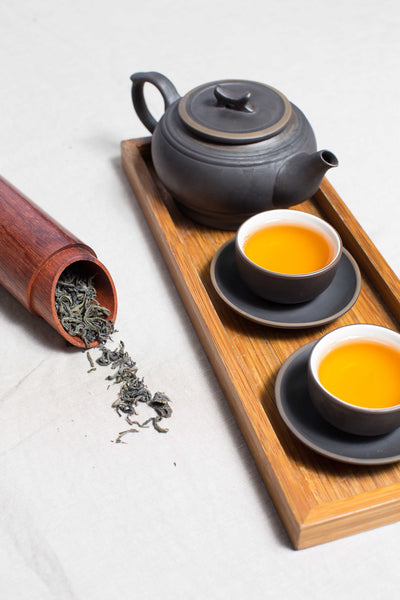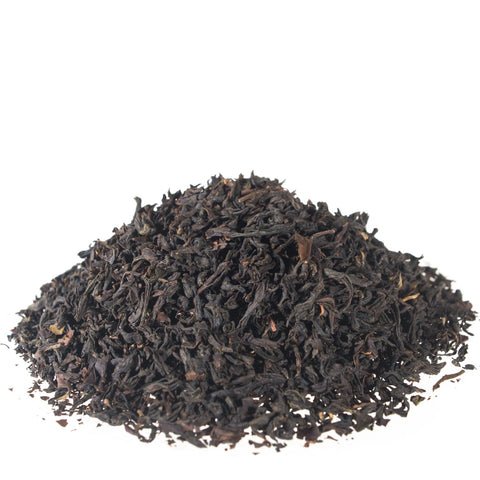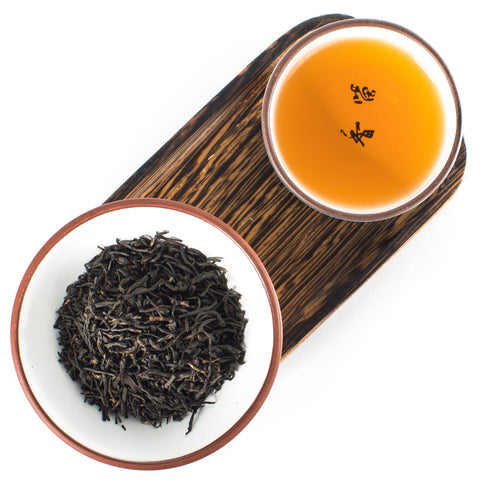Smoky Lapsang Souchong (Zhengshan Xiaozhong) is an acquired taste, much like a ripe pu-erh is. Some people love its deep campfire notes and the warm, comforting feeling the tea provides. Others find these roasted notes too strong and may have unwanted associations with food when drinking the tea. Luckily, for the latter, there is Non-smoky Lapsang Souchong.
Lapsang Souchong is an ancient tea. It was born during the 17th century. The tea was first smoked over pinewood to speed up the drying time of the leaves. It is the first black tea in existence. Read more.
Lapsang Souchong tea originated in the Wuyi Mountains. Nowadays, most Lapsang Souchong tea grows in a semi-wild form on the rocky slopes of Wuyi Mountains. As a result of the terrain, the tea bushes have relatively small tea leaves.

A Little About Black Tea (Red Tea/Hong Cha)
Black tea is an oxidized tea (unlike non-oxidized green teas and semi-oxidized oolongs), thus its dark appearance.
Being fully oxidized, hong cha has dark leaves. It produces a deep amber-colored liquid, as well as tender, yet profound characteristics.
Thanks to its robust and sweet flavor and the fact that it keeps well, it has gained immense popularity across the world.
How is Lapsang Souchong Tea Produced
Both types of Lapsang Souchong are produced the same. The only difference is that the Smoky kind goes through an additional smoking process.
Smoky Lapsang Souchong is produced in a special place called a qing lou. A qing lou is a 3-4 floor building specially built for the smoking of the tea. The tea leaves are placed on bamboo mats and spread out inside of the building. Outside of the building, on the first floor, the pinewood is burned. The pinewood smoke enters the building's top floors through a unique chimney, ensuring that all the tea leaves are appropriately smoked.
Organic Smoky Lapsang Souchong
During processing, Lapsang Souchong tea goes through the following steps:
- picking — the fresh tea leaves are harvested
- withering —the tea leaves are placed on bamboo mats and withered over the pinewood (while other types of Chinese black tea are usually withered under the sun, the Wuyi Mountains don't have many sunny days; thus, the pinewood method is implemented)
- rolling — the tea leaves are rolled to enhance the oxidation processes; this step also helps release the natural oils of the tea leaf
- oxidation — tea leaves are left to oxidize. You can tell that the tea leaves have reached a fair amount of oxidation once they turn a copper color and produce a pleasant scent
- pan-firing — the tea leaves are quickly pan-fired over a high fire to stop the oxidation process (this step is skipped for most other Chinese black teas)
- second rolling — the tea leaves are rolled once again while still hot; this helps the tea leaves absorb more of the pinewood smoke later on
- drying — the tea leaves are dried on bamboo mats up to 10 hours. For Lapsang Souchong production, this is the step where the tea leaves are smoked over the pinewood, developing its signature smoky taste and sweet longan aroma. For Non-smoky Lapsang Souchong (as well as other hong cha varieties), the tea is dried over high fire
- packing — the tea is now ready for packaging and distribution
Even after 10 brews, the smoky flavor of Lapsang Souchong doesn't disappear.
Non-smoky Lapsang Souchong was later developed for people who want to try this tea variety's unique qualities without the robust smoky taste. Instead of smoking the tea leaves, they are dried just like other black teas. The resulting tea is sweet, like honey, and aromatic.
To brew Lapsang Souchong tea:
 1g per 50ml
1g per 50ml ![]() 3-4min
3-4min
 1g per 20ml
1g per 20ml ![]() 5sec + 5sec for each subsequent infusion
5sec + 5sec for each subsequent infusion

